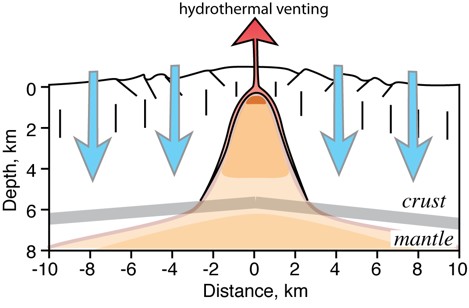Dunn
The L-SCAN Seismic Experiment
R. Dunn¹*, J. Conder², & F. Martinez¹
Corresponding author: dunnr@hawaii.edu
¹University of Hawaii, Dept. of Geology and Geophysics, Honolulu, HI, 96822
²Southern Illinois University, Dept. of Geology, Carbondale, IL, 62901
Abstract:
The L-SCAN (Lau Spreading Center Active-source Investigation) seismic experiment is designed to examine the relationship between melt supply and magmatic, tectonic, and hydrothermal processes along the Eastern Lau Spreading Center. The 6-week experiment was recently carried out aboard the R/V Langseth in January-March, 2009. We deployed 84 4-component ocean bottom seismometers (OBS), obtained from the OBSIP national instrument pool, over a 40 x 100 sq. km area centered on the ridge at 20˚30'S. Sixty-five seismic lines (50-150 km in length) were shot using the Langseth's 36-gun airgun source, generating ~1 million seismic travel time observations. Over the experiment area, the data will be used to image the upper few kilometers of mantle, crustal thickness, and the entire crustal section in 3-D. The experiment area extends across three sections of ridge separated by two overlapping spreading centers (OSC). The southernmost “inflated” section is underlain by an AMC reflector that terminates near the OSC; the central section consists of a deeply rifted ridge axis without a known AMC reflector; the northernmost section is also devoid of an AMC reflector and appears to have a long-term reduced magma supply as compared to the other segments. We have just begun to process and analyze the data from the L-SCAN experiment. Nevertheless, our initial examination of the data has revealed that along the southern ridge section, the sub-axial low-velocity zone, indicative of high temperatures and melt, is restricted to a narrow region. Only P-wave seismic energy that has traveled within ~2 km of the ridge axis exhibits the travel time delays indicative of a crustal low-velocity "mush” zone. Previously, narrow magmatic systems have been interpreted as requiring large off-axis hydrothermal cells to cool the off-axis crust. However, no significant seafloor venting occurs away from the axial zone along the ELSC. Therefore we suggest an alternative scenario: the narrow crustal magmatic system acts as the primary driving force for hydrothermal buoyancy and upward flow, and that substantial upward flow only occurs along the borders of the magmatic system. Above the magmatic system, fluid is further focused to the axial zone by dikes above the melt lens and perhaps by its own buoyancy. Off-axis crust will already have passed through this cooling process and does not requires large off-axis hydrothermal cells for cooling.
Keywords:
Crustal Magmatic System, Hydrothermal Circulation, Seismic Tomography
Contributions to Integration and Synthesis:
The L-SCAN study will help resolve several outstanding issues that are of continuing interest to a variety of fields of ridge study. For example: (1) Controls on ridge morphology: what controls the cross-sectional area of a ridge, the formation of an axial rift versus a rise, and the axial segmentation in the form of OSCs and other offsets? Morphology has long been considered to reflect interplay between magmatic and tectonic processes, yet the details remain unclear. (2) Controls on hydrothermal circulation: what is the significance that hydrothermal fluid output is restricted to a narrow region at the ridge axis? What is the deeper and perhaps broader pattern of hydrothermal circulation? The L-SCAN seismic data will reveal relevant details of the crustal structure of the ELSC. This information will be integrated with other data to create self-consistent models of ridge tectonic, magmatic, and hydrothermal processes.
Figures:
Figure 1. Cartoon depiction of a ridge magmatic and hydrothermal system. Seismic studies indicate that the magmatic system is confined to a narrow region in the crust, while water column and other studies indicate that the great majority of venting occurs within a narrower region along the ridge axis. Together, these observations suggest that off-axis hydrothermal flow is, for the most part, downward, whereas near-axis flow cloaks the magmatic system. Fluid follows the edges of the magmatic system upward and is further focused to the ridge axis by dike/s above the melt lens and perhaps its own buoyancy. Large hydrothermal convection cells do not exist off axis. Dunn_fig1.jpg

